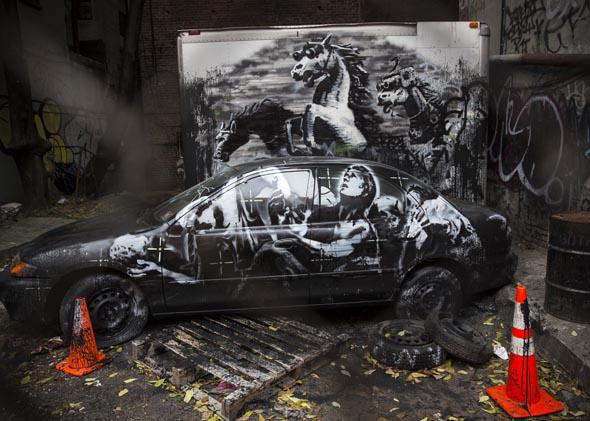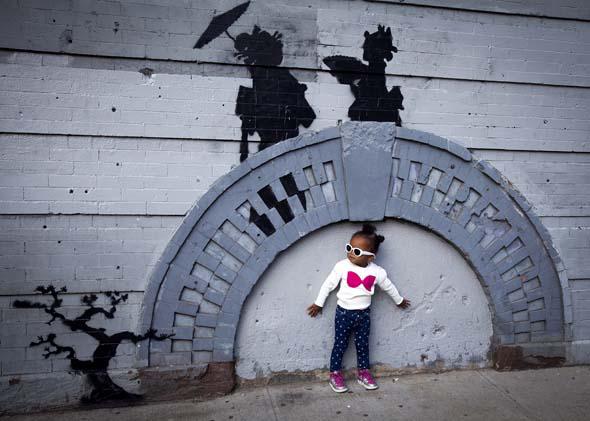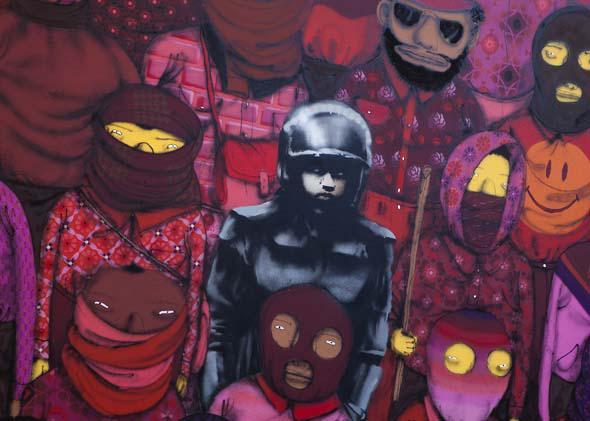I was all set to write something snarky about the media frenzy around Banksy’s current month-long, self-declared “residency” in New York, for which the famed British street artist has been seeding daily guerrilla art interventions across the Big Apple. I’m less dismissive of Banksy than other art critics—Jerry Saltz pans him as “the easy-access photorealist of graffiti artists”—but I do wonder if his presence really is worth so much hype when our own native New York graffiti landmarks, like Long Island City’s imperiled 5 Pointz, are being turned into condos. But then, last week, outgoing mayor Michael Bloomberg weighed in, and opened my eyes to the beauty of it all.
Bloomberg made his remarks at a press conference to mark the opening of a new water tunnel beneath Central Park—an important event but one that literally falls beneath the field of interest of most New Yorkers, so I suppose reporters were trying to spice things up when they brought up Banksy. New York’s dependable tabloids portrayed the mayor as declaring war on the elusive artist, conjuring tantalizing visions of a Keystone Cops-style manhunt. In truth, however, Bloomberg’s musings are more philosophical than anything else. Here they are, in their full glory:
I’ll leave it up to our Department of Cultural Affairs. But look, graffiti does ruin people’s property and it’s a sign of decay and loss of control. Art is art. And nobody’s a bigger supporter of the arts than I am. I just think there are some places for art and there are some places [not for] art. And you running up to somebody’s property or public property and defacing it is not my definition of art. Or it may be art, but it should not be permitted. And I think that’s exactly what the law says.
Readers curious about the object of the mayor’s distaste can click on over to the website for “Better Out Than In,” which is the name of the month-long Banksy plot to dot the city with “elaborate graffiti, large scale street sculpture, video installations, and substandard performance art.” There, Team Banksy is teasing fans with daily news of his latest exploits. Some are goofy stencils of the kind he is most famous for (a dog peeing on a fire hydrant, which sprouts a thought balloon that says “You Complete Me”) or quick-fire jokes (a series appending the words “The Musical” to a pre-existing scrawl: “Dirty Underwear: The Musical,” “Occupy: The Musical,” and so forth). Others are more involved stunts—two so far have incorporated trucks that circle the city (one with a bucolic landscape incongruously placed in the cargo bay and one transporting a screaming gaggle of animatronic stuffed animals, as if to slaughter).

Photo by Andrew Burton/Getty Images
Bloomie and Banksy would appear at first glance to be natural antagonists. The former is a financial services billionaire who will leave behind a city perhaps more unequal than it has ever been. As for Banksy, you can argue about whether his signature brand of “anti-authoritarian whimsy” (as one commentator dubbed it) is just shtick, but you have to admit that he has the common touch: His sense of humor is generally leveled against the powerful. Last week’s best piece was a Ronald McDonald sculpture, unveiled in front of a Bronx outlet of the burger chain. The effigy came complete with a real live boy dressed as a Depression-era street urchin, tasked with buffing the sculpture’s grotesquely exaggerated (even by clown standards) shoes—a likely reference to NYC’s fast food workers’ ongoing fight for a living wage.
Subject matter aside, Bloomberg has staked his reputation on a form of “broken windows” policing so aggressive that a court actually has deemed it criminal. It is therefore perfectly logical that, when faced with news of a marauding graffiti artist, what comes to his mind is “decay and loss of control.” Left unchecked, Banksy’s antics might inspire untold numbers of New Yorkers to engage in droll outbursts of public art, with who knows what consequences!

Photo by Daniel Pierce Wright/Getty Images
And yet, if Bloomberg really thought about it, the Banksy “residency” might well offer him much more to love than hate. What strikes me about the mayor’s remarks is that he is stuck in a ’70s narrative about graffiti. The new narrative of street art isn’t that it is a sign of impending urban apocalypse; it is that it’s worth lots and lots of money. Heck, in places like Miami, developers deliberately woo street art stars to boost neighborhood cachet. And Banksy is the biggest star of all.
“Better Out Than In” only really hit its stride in terms of piquing public interest on Oct. 13, when Banksy set up a stall in Central Park selling signed canvasses of his work for $60. The result was a jubilant torrent of stories about how a few canny tourists hit the jackpot—the works might well sell for tens of thousands of dollars each—which shows how the fascination with Banksy is often less about his scrappy politics and more about his ability to spray gold from his magic paint can. It’s this part of his legend that has made him a running gag on the Colbert Report all month; Stephen Colbert has even framed a section of bare wall in front of his studio, sternly warning Banksy not to be tempted. “The last thing I want,” Colbert raged, “is for the front of my building to be vandalized, and for its property value to skyrocket!”

Photo by Carlo Allegri/Reuters
If lifestyle policing has been one pillar of the Bloomberg era, the other has been courting the wealthy and business interests by selling NYC as “luxury city.” You’d think, then, that a world-famous entrepreneur setting up shop for an ambitious citywide project would be welcome. The trickle-down economic benefits of Banksy’s “residency” have been much in the news in recent days. In Williamsburg, a business owner thinks his mural so valuable that he’s hired guards and had a gate built to protect it—so there are some jobs created right there. In East New York, an enterprising duo threw a box over a Banksy stencil and started charging $20 for visitors to see it. And best of all, unlike most city-backed art initiatives, Banksy’s “residency” is self-funded; it is, in essence, a completely laissez-faire program of public art.
Bloomberg talks a good game about supporting art, but I’m with David Byrne, who recently published an angry essay lamenting how New York has become rather inhospitable to creativity: “Middle-class people can barely afford to live here anymore, so forget about emerging artists, musicians, actors, dancers, writers, journalists and small business people.” For his part, Banksy believes there’s something left to love, something that hasn’t been buffed out yet: “New York calls to graffiti writers like a dirty old lighthouse,” he told the Village Voice—though he did add, “Maybe I should be somewhere more relevant, like Beijing or Moscow, but the pizza isn’t as good.” Not a ringing endorsement, but I’ll take it. At any rate, even if Bloomberg can’t bring himself to embrace “Better Out Than In,” he might think of it as a kind of prophecy of the future he is leaving for us: a city where artistic spark has to be imported from without, because nobody here can afford to take any real risks.
